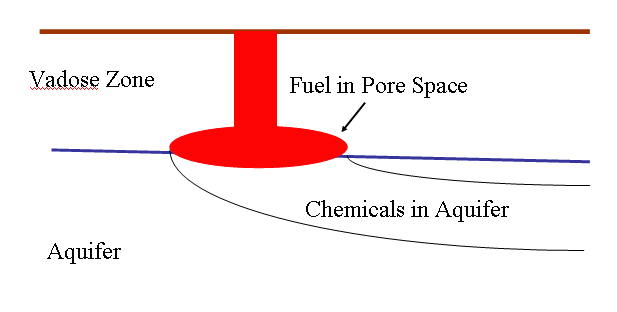Modeling Subsurface Petroleum Hydrocarbon Transport
Module Home Objectives Table of Contents ← Previous Next →
1 of 36
Petroleum hydrocarbon plumes begin obviously enough with a release. For Underground Storage Tanks (USTs), the release is normally of a fuel.

First the fuel: The fuel (indicated by red on the figure) is immiscible with water. As we all know oil and water don't mix. Oil and water don't mix above the ground and they don't below the ground, so the oil (fuel) forms distinct bodies in the subsurface. Because of the influence of the solids, these are in the form of droplets or blobs. A module of the course describes various aspects of these droplets. The components of fuels have varying solubilities in water so that some of the fuel (more precisely, some components of the fuel) dissolves into water. The amount that each component does so depends on the chemical and its properties.
In an aquifer, components of the fuel are transported with the ground water. The contaminants move with the ground water and show signs of the apparent mixing that is usually characterized by dispersion. (The words in the phrase about dispersion have been carefully chosen as you'll see later on.) The contaminants can sorb onto the aquifer materials causing them to move slower than the ground water. Biodegradation limits the size of benzene, toluene, ethylbenzene and xylene (BTEX) plumes. Methyl tert-butyl ether (MTBE) is influenced to a differing degree, such that it's plumes can migrate further.
After this introduction, modules will describe these four phenomena (ground water flow, dispersion, sorption and biodegradation) in more detail.
Home | Glossary | Notation | Links | References | Calculators
